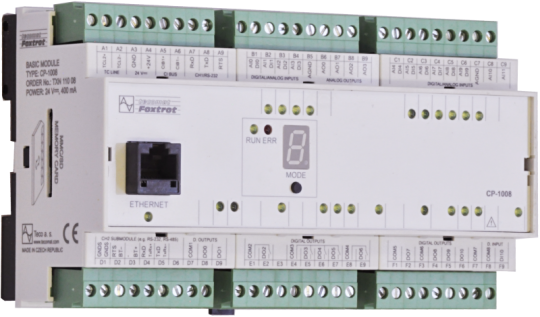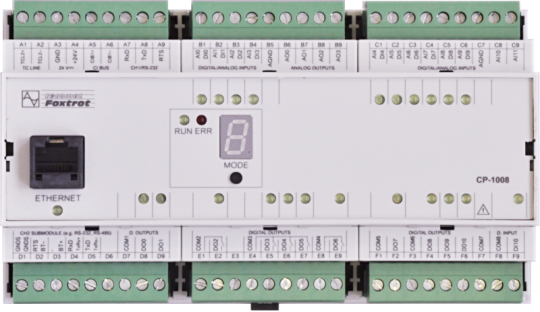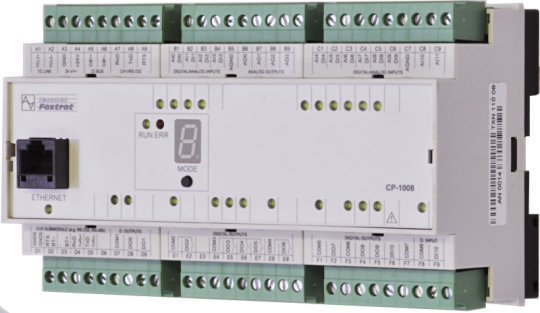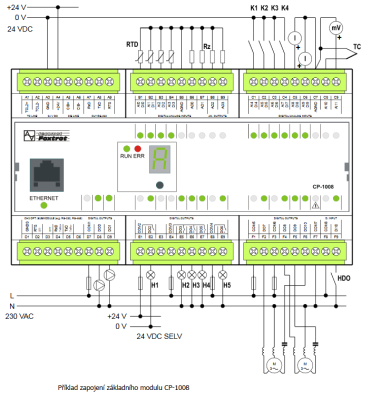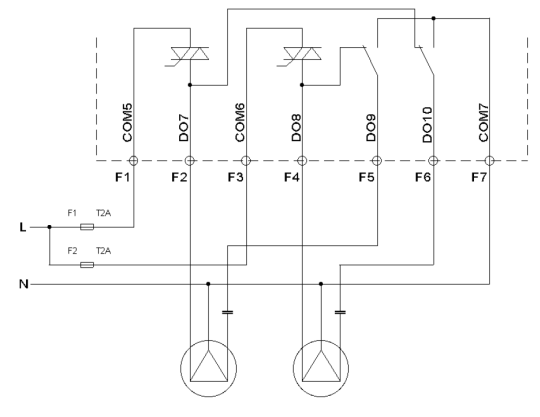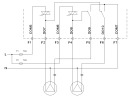CP-1018TXN 110 18
CP-1018, CPU+LCD, ETH100/10, 1xRS232, 1xSCH, 10xAI/DI, 2xAI, 4xAO, 7xRO, 4xSSR, 1xCIB
| DI | 1x DI/230V AC |
|---|---|
| DI/AI | 10x DI/AI |
| DO | 7x RO 4x SSR |
| AI | 2x AI |
| AO | 4x AO |
| COM | 1x ETH 1x RS-232 1-3x Serial channel (1x free slot) 1x TCL2 1x CIB |
| SENSOR |
The basic module CP-1008 is equipped:
- ten multipurpose inputs, each of which can be used either as analog or as binary
- two analog inputs, which can be used for voltage measurement or for connecting thermocouples and a lambda probe one binary input for 230 V AC
- four triac outputs, usable as PWM outputs
- four analog outputs 0 to 10 V
- seven relay outputs (two relay outputs are connected to triac outputs and allow control of the direction of AC motors).
| Order num. | TXN 110 18 |
|---|---|
| Teco code | TXN 110 18 |
| Categories | Foxtrot 1 - Basic modules |
| Tags | Sales and production discontinued |
| System parameters of the central unit | |
|---|---|
| Row of central unit | K |
| User program memory | 192 + 64 kB |
| Memory for user variables / including RETAIN variables | 64 kB/32 kB |
| Instruction length | 2 ÷ 10 bytes |
| Backup of program source code in PLC | Yes, in program backup memory (EEPROM) |
| On-line program change in PLC | Yes, including I / O configuration change |
| Memory for project archiving - internal | 2 MB |
| DataBox - additional internal data memory | 512 kB |
| Optional memory card slot | SD - Card Slot |
| Cycle time per 1k of logic instructions | 0,2 ms |
| Development environment | Mosaic |
| Programming languages | ST, IL, LD, FBD, SFC, CFC |
| RTC - Real time circuit | No |
| RAM and RTC backup 1) without / with backup battery | type. 500 hr / typ. 20,000 hours |
| Integrated Web server | Yes |
| Integrated Datalogger | Yes |
| Access to PLC variables via web API | Yes |
| Notice | 1) Applies to the basic module without power supply, the backup circuits are disconnected when the power supply is switched on 2) The serial interface CH1 is permanently equipped with an RS-485 interface. The serial interface type CH2 to CH4 is selectable via interchangeable submodules |
| COM - Communication - IP/Ethernet | |
| Ethernet 10/100 Mb (ETHx) | 1 |
| Available system modes on ETH and WLAN | UNI, PC, PLC, PLD |
| TCP / IP protocol | Yes |
| UDP protocol | Yes |
| HTTP protocol | Yes |
| WebSocket protocol | No |
| Protocol MODBUS/TCP | Yes |
| SMTP protocol | Yes |
| IEC 60870-5-104 protocol | Yes |
| REST API | Yes |
| COM - Serial channels | |
| max. number of optional serial channels in the basic module | 4 |
| max. number of expanding serial channels on the TCL2 bus | 6 |
| Number of internal RS-232 serial channels | 1 |
| Available system modes on CH5-10 | UNI, CSJ (CAN) |
| Modbus RTU / ASCII master protocol | No |
| Modbus protocol RTU/ASCII slave | No |
| Profibus DP master protocol (<180 kbit/s) | No |
| COM - System buses | |
| TCL2 - system I/O bus | 1x TCL2 master |
| TCL2 - Range of one branch of the system I/O bus | 10 I / O modules + 4 operator panels + 6 serial channels |
| The communication rate of the system I / O bus | 345 kbps |
| System I / O bus terminating resistor | 120 Ω |
| CIB - Common Installation Bus (R): Installation I/O bus | 1x CIB master (100 mA) |
| CIB - Address range of one branch of the installation bus | 32 CFox I/O modules |
| DI - Organization of binary inputs | |
| Total number of binary inputs | 11 |
| Number of groups of binary inputs | 2 |
| Organization of binary inputs into groups |
10x DI/AI (DI0/AI0-DI9/AI9) 1x DI 230 V AC (DI10) |
| DI - Parameters of binary inputs DC (group A) | |
| Parameters valid for inputs on the terminals | DI0-DI9 |
| Number of inputs in group | 10 |
| Common wire | GND - module ground |
| Combined input type | DI/AI Active, for sensing potential-free contacts and measuring resistance sensors |
| Galvanic isolation of inputs from internal/peripheral circuits | No |
| Diagnostics | indication of energized input by LED on module panel |
| Input voltage for log. 0 | 2,3 V DC min.; 12 V DC max. |
| Input voltage for log. 1 | 1 V DC max. |
| Input current at log. 1 (typ.) | -1,7 mA |
| Delay from log. 0 to log. 1 | 1 ms |
| Delay from log. 1 to log. 0 | 1 ms |
| Notice |
1) Inputs DI0 - DI9 can alternatively be used as analog (AI0 - AI9). The selection is made for individual inputs from the Mosaic development environment. 2) Due to the possible increase in interference on the analog inputs, it is not desirable to connect the common wire of the input switches to the AGND terminal. |
| DI - Parameters of binary AC inputs | |
| Parameters valid for AC inputs on the terminals | DI10 |
| Total number of binary AC inputs | 1 |
| Number of groups of AC inputs | 1 |
| Number of AC inputs in group | 1 |
| Organization of binary inputs into groups | 1x DI 230 V AC (DI10) |
| Input type | 230 V AC |
| Galvanic isolation of internal circuits | Yes |
| Input voltage for log. 0 | 0 V AC min., 120 V AC max. |
| Input voltage for log. 1 | 230 V AC typ., 200 V AC min., 250 V AC max. |
| Input current at log. 1 (typ.) | 5 mA typ. |
| Delay from log. 0 to log. 1 | 10 ms |
| Delay from log. 1 to log. 0 | 10 ms |
| Notice |
1) Inputs DI0 - DI9 can alternatively be used as analog (AI0 - AI9). The selection is made for individual inputs from the Mosaic development environment. 2) Due to the possible increase in interference on the analog inputs, it is not desirable to connect the common wire of the input switches to the AGND terminal. |
| DO/RO - Organization of binary outputs | |
| Total number of binary outputs | 11 |
| Number of binary output groups | 4 |
| Organization of binary outputs into groups |
2x DO 230 V AC triak (DO0-DO1) 2x DO 230 V AC triak (DO7-DO8) 1x RO (DO6) 2x RO (DO9-DO10) 4X RO (DO2-DO5) |
| DO - Parameters of SSR (solid state relay) outputs (group A) | |
| Parameters valid for the terminals | DO0, DO1 |
| Number of outputs in group | 2 |
| Organization of SSR outputs into groups | 2 (DO0, DO1) |
| Max. current through COM terminal | 2A max. |
| Output type | triac with switching at 0/PWM |
| Galvanic separation of the output | Yes |
| Diagnostics | signaling of excited output by LED diode |
| Switching voltage (V) | min. 20VAC, max. 260VAC |
| Switching current (A) | max. 0,7 A; min. 5 mA |
| Switching current at 25 ° C | IDO7 + IDO8 <4 A Maximum continuous current at which the thermal protection is not activated. If these values are exceeded, both outputs will be periodically disconnected due to thermal protection. |
| Switching current at 50 ° C | IDO7 + IDO8 <2 A Maximum continuous current at which the thermal protection is not activated. If these values are exceeded, both outputs will be periodically disconnected due to thermal protection. |
| Internal protection, output treatment | No |
| Short circuit protection | No |
| Overload protection | no |
| Treatment of inductive load | external - RC element, varistor |
| Insulation voltage between outputs and internal circuits | 3750 V AC |
| Insulation voltage between groups of outputs | 3750 V AC |
| DO - Parameters of SSR (solid state relay) outputs (group B) | |
| Parameters valid for the terminals | DO7, DO8 |
| Number of SSR outputs | 2 |
| Number of output groups | 1 |
| Number of outputs in group | 2 |
| Organization of SSR outputs into groups | 2 (DO7-DO8) |
| Output type | triac with switching at 0 |
| Galvanic separation of the output | No |
| Diagnostics | signaling of excited output by LED diode |
| Switching voltage (V) | min. 180VAC, max. 260VAC |
| Switching current (A) | max. 4 A; min. 50 mA |
| Switching current at 25 ° C | IDO7 + IDO8 < 4 A |
| Switching current at 50 ° C | IDO7 + IDO8 < 2 A |
| Internal protection, output treatment | No |
| Short circuit protection | No |
| Overload protection | thermal protection |
| Treatment of inductive load | internal RC element + varistor |
| Insulation voltage between outputs and internal circuits | 3750 V AC |
| Notice | Maximum continuous current at which the thermal protection is not activated. If these values are exceeded, both outputs will be periodically disconnected due to thermal protection. |
| RO - Parameters of binary relay outputs (group A) | |
| Parameters valid for the terminals | DO2 - DO5, DO9-DO10 |
| Number of relay outputs | 6 |
| Number of output groups | 3 |
| Organization of relay outputs into groups | 1(DO2)+3(DO3-DO5)+2(DO9-DO10)+DO6) |
| Output type | electromechanical relay, unprotected output |
| Contact type | NO - Normally Open |
| Galvanic separation from internal circuits | Yes |
| Galvanic isolation between groups | Yes |
| Diagnose | Alarm signaling on panel module |
| Switching current | 3 A max., 10 mA min. |
| Switching voltage | 250 V AC max., 5 V AC min., 30V DC max. |
| Short-term output overload - inrush | 4 A max. |
| Current through common clamp | 10 A max. |
| Contact closing time | typ. 10 ms |
| Contact opening time | typ. 4 ms |
| Limit values of switched resistive load | max. 3A at 30 V DC or 230 V AC |
| Switching inductive load limits DC13 | max. 3 A at 30 V DC |
| Switching inductive load limits AC15 | max. 3 A at 230 V AC |
| Switching frequency without load | max. 300 switching / min. |
| Switching frequency with rated load | max. 20 switching / min. |
| Mechanical life | min. 5,000,000 cycles |
| Electrical life at maximum resistive load | min. 100,000 cycles |
| Electrical life at maximum load inductive DC13 | min. 100,000 cycles |
| Electrical life at maximum load inductive AC15 | min. 100,000 cycles |
| Short-circuit protection | No |
| Treatment of inductive load | External RC element, varistor (AC), diode (DC) |
| Insulation voltage between outputs and internal circuits | 3750 V AC |
| Isolation voltage between groups of outputs to each other | 3750 V AC |
| Notice! | The insulation strength between groups with a common terminal COM3 and COM4 does not meet the requirements for double insulation. If one group is used for mains voltage, the other group must not be used for SELV or PELV voltage! DO9 + DO10 are connected to SSR outputs, see diagram |
| RO - Parameters of binary relay outputs (group B) | |
| Parameters valid for the terminals | DO6 |
| Number of relay outputs | 1 |
| Number of outputs in group | 1 |
| Organization of relay outputs into groups | 1(DO6) |
| Output type | electromechanical relay, unprotected output |
| Contact type | NO - Normally Open |
| Galvanic separation from internal circuits | Yes |
| Galvanic isolation between groups | Yes |
| Diagnose | Alarm signaling on panel module |
| Switching current | 10 A max., 10 mA min. |
| Switching voltage | max. 250 V AC; max. 30 V DC; min. 5 V |
| Short-circuit protection | No |
| Current through common clamp | 15 A max. |
| Contact closing time | typ. 10 ms |
| Contact opening time | typ. 4 ms |
| Limit values of switched resistive load | max. 10A at 30 V DC or 230 V AC |
| Switching inductive load limits DC13 | max. 10 A at 30 V |
| Switching inductive load limits AC15 | max. 10 A at 230 V AC |
| Switching frequency without load | max. 60 sepnutí/min. |
| Switching frequency with rated load | max. 6 switching / min |
| Mechanical life | min. 5,000,000 cycles |
| Electrical life at maximum resistive load | min. 100,000 cycles |
| Electrical life at maximum load inductive DC13 | min. 100,000 cycles |
| Electrical life at maximum load inductive AC15 | min. 100,000 cycles |
| Treatment of inductive load | External RC element, varistor (AC), diode (DC) |
| Insulation voltage between outputs and internal circuits | 3750 V AC |
| Isolation voltage between groups of outputs to each other | 3750 V AC |
| Notice | The insulation strength between groups with a common terminal COM3 and COM4 does not meet the requirements for double insulation. If one group is used for mains voltage, the other group must not be used for SELV or PELV voltage! |
| AI - Organization of analog inputs | |
| Total number of analog inputs | 12 |
| Number of analog input groups | 2 |
| Organization of analog inputs into groups | 4(AI0-AI3) + 6(AI4-AI9) + 2 (AI10-AI11) |
| Input type | With common clamp |
| Common wire | Minus |
| Galvanic separation from internal circuits | No |
| Diagnostics | signaling overload, disconnection and short-circuiting of the sensor in the status word |
| Type of protection | integrated overvoltage protections |
| External power supply | No |
| Digital resolution | 12 bit |
| Converter type | Approximation |
| Repeat time of sample | 650 μs typ. |
| Total System Input Move Time (TAID + TAIT) | 50 μs typ. |
| Filtration | low pass filter, digital comb filter 50/60 Hz |
| AI - Analog Input Ranges (Group A) | |
| Parameters valid for inputs on the terminals | AI0 - AI3 |
| Passive sensor | Pt1000, W100 = 1,385 (-90 to +400 °C) |
| Passive sensor | Pt1000, W100 = 1,391 (-90 to +400 °C) |
| Passive sensor | Ni1000, W100 = 1,500 (–60 to +200 ° C) |
| Passive sensor | Ni1000, W100 = 1.617 (-60 to +200 ° C) |
| Passive sensor | Resistance transmitter 0-2 kOhm |
| Passive sensor | KTY81-121; PTC thermistor (-55 to + 125 °C) |
| Input impedance in signal range RTD | > 4 kΩ |
| Reference voltage | 8,34 V |
| Resistance measurement error - maximum error at 25 ° C | ± 0.5% of full scale |
| Resistance measurement error - temperature coefficient | ± 0.05% of full scale / K |
| Resistance measurement error - non-linearity | ± 0.09% of full scale |
| Resistance measurement error - repeatability at steady conditions | 0.07% of full scale |
| Max. permissible permanent overload of analog input (without damage) | –20 to +30 V (each AI terminal against AGND) |
| Detection of disconnected sensor | yes, in status word, range overflow |
| AI - Analog Input Ranges (Group B) | |
| Parameters valid for inputs on the terminals | AI4-AI9 |
| Ccurrent | 0 - 20 mA |
| Current | 4-20 mA |
| Current - resolution 1 LSB | 6 μA |
| Input impedance in the current signal range | 100 Ω |
| Passive sensor | Pt1000, W100 = 1,385 (-90 to +400 °C) |
| Passive sensor | Pt1000, W100 = 1,391 (-90 to +400 °C) |
| Passive sensor | Ni1000, W100 = 1,500 (–60 to +200 ° C) |
| Passive sensor | Ni1000, W100 = 1.617 (-60 to +200 ° C) |
| Passive sensor | Resistance sensor 0-2k |
| Passive sensor | Resistance transmitter 0-200kOhm |
| Passive sensor | KTY81-121; PTC thermistor (-55 to + 125 °C) |
| Passive sensor | NTC Thermistor 12k / 25 °C (-40 to + 125 °C) |
| Input impedance in signal range RTD | >4 kΩ |
| Reference voltage | 8,34 V |
| Resistance measurement error - maximum error at 25 ° C | ± 0.5% of full scale |
| Resistance measurement error - temperature coefficient | ± 0.05% of full scale / K |
| Resistance measurement error - non-linearity | ± 0.09% of full scale |
| Resistance measurement error - repeatability at steady conditions | 0.07% of full scale |
| Detection of disconnected sensor | yes, in status word, range overflow |
| AI - Analog Input Ranges (Group C) | |
| Parameters valid for inputs on the terminals | A10-A11 |
| Voltage | 0 to 2 V / 610.4 μV |
| Voltage | 0 to 1 V / 305 μV |
| Voltage | –20 to +50 mV / 19 µV |
| Voltage | –20 to +100 mV / 38 µV |
| Thermocouple | Type J (-210 ° C to 1200 ° C) |
| Thermocouple | Type K (–200 to +1372 ° C) |
| Thermocouple | Type R (-50 to +1768 ° C) |
| Thermocouple | Type N (-200 ° C ÷ 1300 ° C) |
| Thermocouple | Type T (-200 ° C ÷ 400 ° C) |
| Thermocouple | Type B (250 ° C ÷ 1820 ° C) |
| Thermocouple | Type S (-50 ° C ÷ 1768 ° C |
| Lambda probe | 2,85 - 21,21 % |
| Input impedance in the voltage signal range | > 1 GΩ |
| Permissible continuous overload - voltage input | -20 to 30 V (each AI terminal against AGND) |
| Voltage input error - maximum error at 25 ° C | ± 0.4% of full scale |
| Voltage input error - temperature coefficient | ± 0.03% of full scale / K |
| Voltage input error - non-linearity | ± 0.07% of full scale |
| Voltage input error - repeatability under steady state conditions | 0.05% of full scale |
| AO - Analog output parameters | |
| The number of groups of analogue outputs | 1 |
| Number of outputs in group | 4 |
| Common wire of group | minus |
| Galvanic isolation from internal circuits | No |
| Output type | active voltage output |
| Type of protection | integrated overvoltage protections |
| Max. permissible permanent overload (without damage) | ± 20 V, each terminal against AGND |
| Converter resolution | 8 bit |
| conversion time | 10 μs |
| Analog output error - maximum error at 25 ° C | ± 2% of full scale |
| Analog output error - temperature coefficient | ± 0.3% of full scale / K |
| Analog output error - linearity | ± 0.7% of full scale |
| Analog output error - repeatability under steady state conditions | ± 0.5% of full scale |
| Voltage output - voltage | 0 - 10,5 V |
| Voltage output - Resolution 1 LSB | 41 mV |
| Voltage output - maximum output current | 10 mA |
| Power supply | |
| Nominal supply voltage (V) | 24 V DC |
| Supply voltage, tolerances | 24 V DC, +25%, -15%, SELV |
| Supply voltage when backing up with an external battery | 27 V DC, +10%, –15%, SELV |
| Typical power input | 8 W |
| Maximum power input | 10 W |
| Module thermal/power loss | 10 W |
| Maximum current consumption (mA) | 500 mA |
| Galvanic separation of power supply from internal circuits | No |
| Internal protection | Yes, PTC reversible fuse |
| Description of power supply | Difference between typical and maximum power input is given by possible load of CIB buses and number of switched outputs and CPU load |
| CIB branch power supply - parameters of the built-in master | 1x 100 mA/ 24 V DC |
| Size and weight | |
| Weight approx. | 300 g |
| Product dimensions (width x height x depth) | 158 x 92 x 63 mm |
| Module width in multiples of M (17.5 mm) | 9M |
| Module width | 158 mm |
| Module height | 92 mm |
| Module depth | 63 mm |
| Operating conditions, product standards | |
| Product standard | ČSN EN 61131-2: 2005 (idt IEC61131-2: 2003) - Programmable control units |
| Protection class of electrical object | II, according to ČSN EN 61140: 2003 (idt IEC 61140: 2001) |
| IP rating (Ingress Protection) according to ČSN EN 60529: 1993 (idt IEC 529: 1989) | IP20 |
| Operating areas | Normal, according to ČSN 33 2000-3: 1995 (mod IEC 364-3: 1993) |
| Degree of pollution | 1, according to ČSN EN 60664-1: 2004 (mod IEC 60664-1: 1992) |
| Overvoltage category installation | II, acc. ČSN EN 60664-1:2004 (mod IEC 606641:1992) |
| Type of device | Module on DIN rail |
| Working position | Vertical |
| Type of operation (operating frequency) | Continuous |
| Ambient operating temperatures | -20 °C to + 55 °C |
| Operating relative humidity | from 10 % up to 95 % without condensation |
| Operating atmospheric pressure | min. 70 kPa (<3,000 m above sea level) |
| Storage temperatures | –25 °C to +70 °C |
| Electromagnetic compatibility, Mechanical endurance | |
| Electromagnetic compatibility / Emission | A, according to EN 55022: 1999 (mod CISPR22: 1997) |
| Emmisions - note | In premises where the use of radio and television receivers can be expected to be used a distance of 10 m from these devices may cause radio interference. In such a case, the user may be required to take appropriate action. |
| Electromagnetic compatibility / Immunity | min. as required by EN 61131-2: 2007 |
| Sinusoidal vibration endurance | 10 Hz to 57 Hz, amplitude 0,075 mm, 57 Hz to 150 Hz, acceleration 1 G (Fc test according to EN 60068-2-6: 1997 (idt IEC 68-2-6: 1995), 10 cycles per axis.) |
| Packaginng, transportation, storage | |
| Description | The module is packed in a paper box. This documentation is also part of the package. The outer packaging is carried out according to the scope of the order and the method of transport in a transport package provided with labels and other data necessary for transport. The product must not be exposed to direct weather conditions during transport and storage. Malting of the product is only allowed in clean rooms without conductive dust, aggressive gases and vapors. The most suitable storage temperature is 20 ° C |
| Installation | |
| Assembly description | Switchboard mounting |
| Attention! | The device may contain parts with dangerous voltages, covers being removed, or cabling manipulated, or disconnect the appropriate circuits or turn off the power !. |
| Exchangeable submodules | The optional MR-01xx submodules with serial channel 2 interface are mounted on the center plate in the CP-10x0 basic module to the position indicated in Fig. 7.1. To add or replace a submodule with a serial channel interface, release the latches on |
| Connection | |
| Connection via connectors | CIB - terminal block, conductor 2x max. 1,5 mm2 |
| Connection of power and system communication | connector with 1.5 mm2 screw terminal |
| Connection of inputs / outputs | connector with screw terminal 1.5 mm2 |
| Ethernet | RJ-45 |
| Serial channels | screw-type connector 9x 1.5 mm2 |
| Module installation tools | (-) 3 mm, flat screwdriver |
| Module operation | |
| Module configuration | The module is operated, set up and diagnosed from the Mosaic development environment. |
| Module diagnostics | The basic diagnostic system of the module is a part of its standard software. It operates from module power on and operates independently of the user. Diagnostic error states of the module and connected peripheral modules of the assembly are signaled |
| Maintenance | |
| Description | The module does not require any maintenance under general installation conditions. The operations in which a part of the module has to be dismantled must always be carried out with the supply voltage disconnected. |
| Warranty | |
| Generally | Warranty and complaint conditions are governed by the Terms and Conditions of Teco a.s. |
| Notice | You must meet all the conditions of this documentation before turning on the system. The system must not be put into service unless it has been verified and confirmed that the machinery meets the requirements of Directive 89/392 / EEC, in so far as it applies to it. Documentation subject to change. |
HW documentation
CP-1008
337.04 kB, (CS, EN)
User manuals
Foxtrot1 - User's Guide, cze, , TXV00410_01
3.40 MB
Foxtrot1 - User Manual (en), TXV00410_02
4.30 MB
Files for designers
CP-1008
470.66 kB
CP-1008
164.39 kB
- CP-1008 - The CP-1008 is the basic module of the Foxtrot control system. The standard version is in a 9M housing on a DIN rail (for the housing dimensions, see Chapter 13.2.1 9M housing on a DIN rail ), and it is fitted with six removable terminal blocks....
- Power dissipation of modules for calculation of switchboard heating - .../DI, 1xHSC, 1x DI/230V, 2xAO, 10xRO, 2xSSR, 1xCIB CP-1006 7,0 W TXN 110 08 CP-1008, CPU, ETH100/10, 1xRS232, 1xSCH, 10xAI/DI, 2xAI, 4xAO, 7xRO, 4xSSR, 1xCIB CP-1008 10,0 W...
- Internal CIB master at the CP-10xx - ...CP-1006, CP-1016 100 mA 1 A (module C-BS-0001M ) CP-1008, CP-1018 100 mA 1 A (module C-BS-0001M ) ...
- Foxtrot basic module power supply - ...CP-1006, CP-1016 10 W 6 W CP-1008, CP-1018 10 W 6 W 1) All inputs and outputs are ener...
- CP-1000, CP-1001 - ...solar water heating, heat sources control, charging the storage tanks, etc., it is advantageous to use the basic CP-1006 or CP-1008 modules, which have a higher number of inputs for connecting temperature sensors, outputs for continuous speed contro...
- Metering the consumption of 1ph network, the 9901M and ED11.M electricity meter, measuring t - ...S0, see the end of this chapter). The electricity meters that comply with the class B can be connected e.g. directly to the CP-1008 inputs. The SW function block enables you to get the total energy consumed and the calculated instantaneous pow...
- Measuring temperature – technology - ...connected to the analogue inputs of CFox or RFox modules, or directly in the Foxtrot basic modules (e.g. the CP-1006 and CP-1008 ). The range of standard sensors can be found in the price list, and an overview of CFox modules suitable for measu...
- Foxtrot 2 - Shifts to two! - ...rt 2 universal inputs to two analog outputs with a jumper to cover applications. , which required in the previous generation CP-1008, which had four analog outputs. We focused the first information about the new generation of the Tec...
- First generation Tecomat Foxtrot PLC - ..., Provedení: DIN-RAIL, Interface: Multi, Bus: TC700, Input: true, Output: true, Analog: true, Binary: true ] CP-1008 CP-1008-Základní modul Foxtrot [ AI: 2, AO: 4, DO: 11, Typ: PLC-Foxtrot, Výrobce: Teco, Provedení: DIN-RAIL,...
- The FOXTROT basic modules - The CP-10xx analogue inputs, ranges, basic information The analogue inputs in basic modules make it possible to connect a number of sensors and measured signals. Each CP-10xx variant is fitted with various numbers of inputs with different para...
- Heat measurement, produced and consumed heat of DHW and CH (eg heat pump) - To measure heat (produced or consumed) we use a flow meter, eg TA-E/20 with a pulse output, which we connect to the pulse inputs of the C-AM-0600I , modules, or to the binary potential-free inputs of the basic module CP-10x8 , CP-10x6 . T...
- Measurement of production and consumption of el. energy, 3f fast measurement, electricity me - For fast and accurate measurement of 3f network (measurement of phase voltages, currents, active and reactive powers, power factors, THD voltages and currents and frequencies in the LV network, etc.), in the range of rated currents from 15 A to 150...
- Measurement of DC voltage, current and power (PV, etc.) - In applications with photovoltaic panels or a small wind turbine, we sometimes need to measure the DC network - DC voltage, current and power. For measuring voltage up to 400 VDC, current up to 1000 ADC we can use DC electricity meter VMU-E. The bas...
- The SMM33 module for measuring and analysis of 3ph network - In order to provide a detailed analysis of a 3ph network (measuring and monitoring the line and phase voltages, currents, active and reactive power, the power factor, THD voltages and currents and frequencies in the low-voltage network, etc.), you...
- Connecting an electricity meter via the TXN 149 01 optical head - The TXN 149 01 optical interface probe (also called an optical head) is designed to read data and to communicate with the electricity meter, the ripple control receiver and other devices. The probe converts optical signals into signals of the serial...
- Measurement of high temperatures up to 1100 ° C, TC, C-IT-0200I - The flue gas temperature of the boiler and other applications in the field of high temperature measurement can be measured using temperature sensors equipped with a thermocouple sensor. Thermocouples can be measured with the C-IT-0200I module (...
No data available.
 English
English
